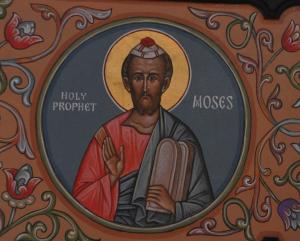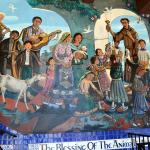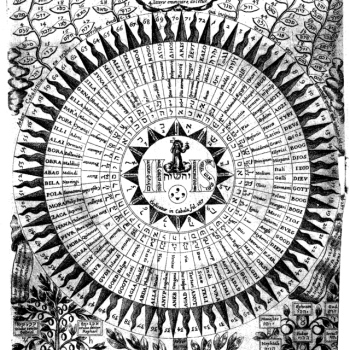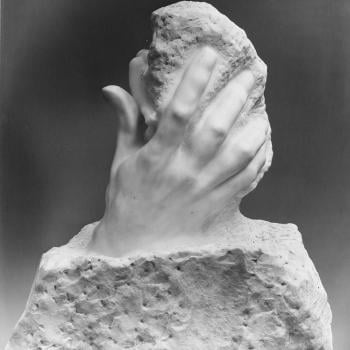
One of the greatest, indeed, perhaps the greatest religious figure in the pre-Christian era, was Moses.[1] It is true, Jesus said no one born of a woman was greater than St. John the Baptist, but what he said had to deal with personal holiness.[2] St. John was not sent into the world to be a great religious figure, establishing particular religious rites and practices, but rather, as to be the prophet who pointed the way to Jesus, the messiah, the prophet like unto Moses (cf. Deut. 18:15). Moses was a great religious leader, establishing a religious way of life for a whole religious community, while John knew his mission was not to establish or create a new religious rite, but to prepare people for the baptism of the Holy Spirit and the transformation which was to take place on the earth. Moses provided the foundation from which John – and then Jesus – could emerge.
It is not, of course, that Moses was not himself transitional. He was. But it was a different kind of transition. Moses represented the culmination of all that came before him, setting the stage for a new religious paradigm in the world. He took not only from the tradition of the people of Abraham, but from the world at large. Indeed, his time in Egypt, being raised by the Pharaoh’s daughter, gave him insight on the great religious traditions of Egypt. When Moses helped the people of Israel out of Egypt, he is said to have “despoiled” Egypt, taking its treasures; this included the great religious treasures of Egypt. As Elijah Benamozegh explained, Moses took much from the religious rites and attitudes he found in Egypt, translating them, indeed, purifying for use with the people of Israel: what could have been seen as proper for the priestly cast of Egypt was transferred to the whole people of Israel:
The most rigorous Jewish orthodoxy cannot fail to recognize the influence of the Egyptian mysteries on the lawgiver of the Hebrews; and these borrowings, in which rationalism has found a decisive objection to the Mosaic revelation, appear, to the contrary, like a ringing confirmation of our principles.
Moses seized what was in the Egyptian religion the sole possession of a hieratic caste and transferred it to Israel, a nation entirely priestly. Circumcision, for example, which was a distinguishing sign of initiates, became the common law of the Jews. What had been the privilege of a few adepts was henceforth the heritage of an entire people, who thus became the priests of mankind. [3]
Obviously, Moses did not just transfer what he found in Egypt, he changed it, using its cultic sensibilities and developing them along new avenues of thought as he established the new religion for the People of Israel. He took what was already within his people’s heritage, from the tradition which traced itself back to Abraham (and before), and added to it the revelation which he received from his own experience with God, and combined it with the best of the religious practices he could find in Egypt and elsewhere (including Canaan) to keep the people of Israel satisfied. It was all a part of the progression which was necessary – the people of Israel knew and understood some of the glory they had seen in Egypt, and so they had a religious sensibility which expected elements from what they had learned from Egypt. This sometimes meant they were tempted to go beyond Moses takes not just what was good but what was bad and corrupt from their surroundings.[4] While God conferred upon Moses revelation, based upon Moses’ experience of God, talking to him “face to face,” Moses took what he learned from it, which was a significant religious advance, but put it in forms which had the marks of his own genius behind it. The Law of Moses is the combination of what God revealed to him with the way he interpreted it and set it out for the people of Israel. Much of the particular laws and practices can be said to be secondary reflection of Moses based upon the revelation given to him: they are authentic because they are derived from authentic revelation and inspired by the Holy Spirit, but they still hold the mark of Moses’ involvement with them, showing how God does give humanity some freedom in the way it develops its relationship with him.
Moses, moreover, represented a great moral revolution. He wasn’t the first prophet, the first great holy man which represented a spiritual advance, but he was the greatest of such holy prophets up to his day “Religious progress can be seen even before Moses. Men grow morally: Abraham is superior to Noah, and Moses is greater than Abraham.”[5] Even after him, there was, in a sense, no one else like him; yes, the messiah, Jesus, would be the prophet like unto Moses in that Jesus came and offered the “new law” which was connected with and developed from what was given to Moses at Sinai, but Jesus was the God-man, while Moses was just a man. Moses relied upon revelation: Jesus was the giver of revelation. But, as Scripture said, there is no other prophet who knew the Lord face to face in the way Moses did (cf. Deut. 34:11). Christians cannot abandon Moses; they cannot ignore him; they cannot reject the law which he gave: when they do so, they have already lost their vision of salvation history. The gains of the past are never lost, but rather, they must always be incorporated in what transcends them. Thus, the prophets which came after Moses continued to follow him with their calls not only to monotheism (and its rejection of idolatry), but to moral reform, as Abraham Isaac Kook indicated:
Prophecy saw the great evil of idolatry in ancient Israel, and protested against it with all its might; it envisioned the majesty and delight associated with the belief in one God, and it portrayed it in all its radiance. It saw the corruption in moral depravity, the oppression of the poor, murder, adultery, and robbery, and it was infused with the spirit of God to offer help to and rectify these conditions through lofty and holy exhortations.[6]
Prophetic reform has always included—and will always include – proclamations of justice with special reference to the liberation of the oppressed. The story of Israel’s exodus is the story of liberation, the story of God working for those who were poor and oppressed, freeing them from oppression while making Egypt, their oppressors, suffer the consequences of their injustice. The same pattern is repeated time and time again in Scripture: injustice brings out the pathos of God, a prophet rises up speaking on behalf of those unjustly abused, and in the end, those oppressors who do not repent and change their ways find the weight of their injustices falling upon them, destroying them as their victims are freed. Moses, with the exodus, gives the model, the model which can then be seen even in the conquest of Jesus over sin and death, which is the way many patristic authors allegorically interpreted the Torah.
Likewise, now with the coming of God, with the incarnation we can now experience and partake of the glory which Moses himself experienced on Sinai. With Jesus, we can come to God “face to face.” Moses, in his encounter with God, was transformed; the light of God’s grace shown in and through Moses. We can experience that grace, and incorporating it int our lives, follow through with its directions and be like Moses, a prophet speaking the pathos of God, working for justice. That is, as St. Gregory of Nyssa exhorted, we should follow Moses, participate in the glory of God, divesting ourselves of all things which can get in the way between us and God, so that we can then become a minister to others, destroying tyranny around us:
In the same way that Moses on this occasion attained to this knowledge, so now does everyone who, like him, divests himself of the earthly covering and looks to the light shining from the bramble bush, that is, to the Radiance which shines upon us through this thorny flesh and which is (as the Gospel says the true light and the truth itself). A person like this becomes able to help others to salvation, to destroy the tyranny which holds power wickedly, and to deliver to freedom everyone held in evil servitude.[7]
We might not be called to be law-makers, to establish a great covenant, because the greatest covenant, the covenant established in the blood of the lamb, is now before us; but we still can follow Moses in working to free those who suffer the bonds of tyranny, to cry out for the oppressed, and demand they be let go from those who would do them ill. It is a part of God’s expectation for us if and when we experience his glory. Salvation is tied with the way we engage God and his glory: the Gospel message incorporates social justice because there is no prophecy of God which does not incorporate the dictates of justice in it. It is in this manner, we read in St. Hildegard, how Abraham and Moses inspired the justice needed in humanity so that the Incarnation of God could be established, and from the incarnation, we can, with Adam, be led in righteousness to God the Father:
But you can see that the stone part goes from the north corner around the west corners and ends in the east corner. This means that the righteous works of humans, with which God fortified them, came forth from the north corner, which is to say from the circumcision of Abraham and the Law of Moses, and the justice they inspired in people. They continued to the west corner, where open justice arose in the Incarnation of the Son of God; went on from there to the south corner, where through baptism and other just works of the new-chosen Bride of the Son of God ardent deeds were enkindled to restore Adam to salvation; and at last returned to the east corner, to end restored to the Supreme Father.[8]
Moses, the great Moses, is a figure not just of the past, but a great, continuous figure for all time. When the Apostles saw him on Mt. Tabor with Elijah, they saw that the Law and Prophets would continue side by side with Christ, that they would not be lost, just transfigured. This is why it was necessary for early Christians like Origen to write against Marcion and all others who would do away with the Tanakh. Moses, and his ways, might need to be interpreted under the lens of Christ, but unlike the way Moses took from the Egyptians what was useful, leaving aside the rest, Christians must find a way to incorporate the whole of the Law of Moses into their religious outlook, as indicated by the troparion for his feast:
The choir of prophets rejoices with Moses and Aaron today, / for the fulfillment of their prophecy is in our midst. / The Cross, by which You have saved us, shines forth today. / By their prayers, O Christ God, have mercy on us (Troparion for the Feast of the Holy Prophet Moses).
Moses, the great Moses, is one of the greats of humanity. The grace he experienced and took within him raised him up beyond human expectations: thus, what we know of Moses is not just simple positivistic history, but myths and legends which transcend such historicism. Hopefully we can and will come to know him as we, too, are raised up and transfigured in the light of God’s grace. He is there waiting for us.
[1] We only have glimpses of Moses’ relationship with God. Much of it is lost to us; just as he had to cover himself with a veil, so his revelation itself was veiled in symbol and was aimed at helping the people of Israel in his day and age.
[2] Also, Jesus did not say there was no one who was John’s equal.
[3] Elijah Benamozegh, Israel and Humanity. Trans. Maxwell Luria (New York: Paulist Press, 1995), 78.
[4] This temptation is not a temptation only for the people of Israel, but for all humanity,
[5] Elijah Benamozegh, Israel and Humanity, 69.
[6] Abraham Isaac Kook, “The sage is more important than the prophet” in The Lights of Penitence, Lights of Holiness, The Moral Principles, Essays, Letters and Poems. Trans. Ben Zion Bokser (New York: Paulist Press 1978), 253.
[7] St. Gregory of Nyssa, The Life of Moses. Trans. Everett Ferguson and Abraham J. Malherbe (New York: Paulist Press, 1978). 60-1.
[8] St. Hildegard of Bingen, Scivias. Trans. Mother Columba Hart and Jane Bishop (New York: Paulist Press, 1990), 333.
Stay in touch! Like A Little Bit of Nothing on Facebook.
If you liked what you read, please consider sharing it with your friends and family!













